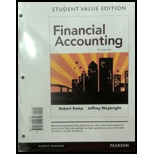
Financial Accounting, Student Value Edition (4th Edition)
4th Edition
ISBN: 9780134114811
Author: Robert Kemp, Jeffrey Waybright
Publisher: PEARSON
expand_more
expand_more
format_list_bulleted
Concept explainers
Textbook Question
Chapter 1, Problem 11SE
Entering transactions in the
As a manager of a department store, you must deal with a variety of business transactions. Place the letter of each of the following transactions next to the effect it has on the accounting equation.
- a. Paid cash to the stockholders as a distribution of earnings
- b. Paid cash to purchase land for building site
- c. Paid cash on an account payable
- d. Sold stock to stockholders
- e. Received cash from the bank in exchange for a note payable
_______ 1. Increase an asset and increase
_______ 2. Increase an asset and increase a liability.
_______ 3. Increase one asset and decrease another asset.
_______ 4. Decrease an asset and decrease stockholders' equity.
_______ 5. Decrease an asset and decrease a liability.
Expert Solution & Answer
Want to see the full answer?
Check out a sample textbook solution
Students have asked these similar questions
I need help with this solution and accounting question
Hello tutor solve this question accounting
I need help with this problem and accounting
Chapter 1 Solutions
Financial Accounting, Student Value Edition (4th Edition)
Ch. 1 - The text states that accounting is the "language...Ch. 1 - Would you describe accounting as primarily a...Ch. 1 - Prob. 3DQCh. 1 - What are some reasons why accounting has adopted...Ch. 1 - What are some of the uses of financial statements?Ch. 1 - Prob. 6DQCh. 1 - Prob. 7DQCh. 1 - How is the accounting equation affected by each of...Ch. 1 - In what order should the financial statements be...Ch. 1 - Which financial statement would be most useful to...
Ch. 1 - Prob. 1SCCh. 1 - Prob. 2SCCh. 1 - Which accounting principle specifically states...Ch. 1 - Wave Rider is famous for custom skateboards. At...Ch. 1 - Assume that Wave Rider sold skateboards to a...Ch. 1 - Assume that Wave Rider sold skateboards to another...Ch. 1 - Assume that Wave Rider paid expenses totaling...Ch. 1 - Consider the overall effects of the transactions...Ch. 1 - Prob. 9SCCh. 1 - Prob. 10SCCh. 1 - Prob. 11SCCh. 1 - Prob. 12SCCh. 1 - Accounting principles (Learning Objective 4) 5-10...Ch. 1 - Accounting principles (Learning Objective 4) 5-10...Ch. 1 - Prob. 3SECh. 1 - Basic accounting equation (Learning Objective 5)...Ch. 1 - Prob. 5SECh. 1 - Prob. 6SECh. 1 - Prob. 7SECh. 1 - Entering transactions in the accounting equation...Ch. 1 - Prob. 9SECh. 1 - Prob. 10SECh. 1 - Entering transactions in the accounting equation...Ch. 1 - Prob. 12SECh. 1 - Transaction analysis (Learning Objective 5) 5-10...Ch. 1 - Prob. 14SECh. 1 - Basic accounting equation (Learning Objective 5)...Ch. 1 - Prob. 16AECh. 1 - Prob. 17AECh. 1 - Prob. 18AECh. 1 - Transaction analysis (Learning Objective 5) 15-20...Ch. 1 - Prob. 20AECh. 1 - Prob. 21AECh. 1 - Prob. 22AECh. 1 - Basic accounting equation (Learning Objective 5)...Ch. 1 - Prob. 24BECh. 1 - Prob. 25BECh. 1 - Prob. 26BECh. 1 - Transaction analysis (Learning Objective 5) 15-20...Ch. 1 - Prob. 28BECh. 1 - Prob. 29BECh. 1 - Prob. 30BECh. 1 - Transaction analysis and the calculation of net...Ch. 1 - Prob. 32APCh. 1 - Prob. 33APCh. 1 - Prob. 34APCh. 1 - Prob. 35APCh. 1 - Transaction analysis and the calculation of net...Ch. 1 - Prob. 37BPCh. 1 - Prob. 38BPCh. 1 - Prob. 39BPCh. 1 - Prob. 40BPCh. 1 - Prob. 1CECh. 1 - Prob. 1CPCh. 1 - Prob. 1CFSAPCh. 1 - Prob. 1EIACh. 1 - Prob. 2EIACh. 1 - Prob. 1FACh. 1 - Prob. 1IACh. 1 - Prob. 1SBACh. 1 - Prob. 1WC
Knowledge Booster
Learn more about
Need a deep-dive on the concept behind this application? Look no further. Learn more about this topic, accounting and related others by exploring similar questions and additional content below.Similar questions
- Oriole Company sells product 2005WSC for $55 per unit and uses the LIFO method. The cost of one unit of 2005WSC is $52, and the replacement cost is $51. The estimated cost to dispose of a unit is $6, and the normal profit is 40% of selling price. At what amount per unit should product 2005WSC be reported, applying lower-of-cost-or-market?arrow_forwardNonearrow_forwardGeneral accountingarrow_forward
arrow_back_ios
SEE MORE QUESTIONS
arrow_forward_ios
Recommended textbooks for you
 College Accounting (Book Only): A Career ApproachAccountingISBN:9781337280570Author:Scott, Cathy J.Publisher:South-Western College PubCentury 21 Accounting Multicolumn JournalAccountingISBN:9781337679503Author:GilbertsonPublisher:Cengage
College Accounting (Book Only): A Career ApproachAccountingISBN:9781337280570Author:Scott, Cathy J.Publisher:South-Western College PubCentury 21 Accounting Multicolumn JournalAccountingISBN:9781337679503Author:GilbertsonPublisher:Cengage Financial AccountingAccountingISBN:9781337272124Author:Carl Warren, James M. Reeve, Jonathan DuchacPublisher:Cengage Learning
Financial AccountingAccountingISBN:9781337272124Author:Carl Warren, James M. Reeve, Jonathan DuchacPublisher:Cengage Learning Financial AccountingAccountingISBN:9781305088436Author:Carl Warren, Jim Reeve, Jonathan DuchacPublisher:Cengage Learning
Financial AccountingAccountingISBN:9781305088436Author:Carl Warren, Jim Reeve, Jonathan DuchacPublisher:Cengage Learning Auditing: A Risk Based-Approach (MindTap Course L...AccountingISBN:9781337619455Author:Karla M Johnstone, Audrey A. Gramling, Larry E. RittenbergPublisher:Cengage Learning
Auditing: A Risk Based-Approach (MindTap Course L...AccountingISBN:9781337619455Author:Karla M Johnstone, Audrey A. Gramling, Larry E. RittenbergPublisher:Cengage Learning

College Accounting (Book Only): A Career Approach
Accounting
ISBN:9781337280570
Author:Scott, Cathy J.
Publisher:South-Western College Pub

Century 21 Accounting Multicolumn Journal
Accounting
ISBN:9781337679503
Author:Gilbertson
Publisher:Cengage


Financial Accounting
Accounting
ISBN:9781337272124
Author:Carl Warren, James M. Reeve, Jonathan Duchac
Publisher:Cengage Learning

Financial Accounting
Accounting
ISBN:9781305088436
Author:Carl Warren, Jim Reeve, Jonathan Duchac
Publisher:Cengage Learning

Auditing: A Risk Based-Approach (MindTap Course L...
Accounting
ISBN:9781337619455
Author:Karla M Johnstone, Audrey A. Gramling, Larry E. Rittenberg
Publisher:Cengage Learning
The KEY to Understanding Financial Statements; Author: Accounting Stuff;https://www.youtube.com/watch?v=_F6a0ddbjtI;License: Standard Youtube License